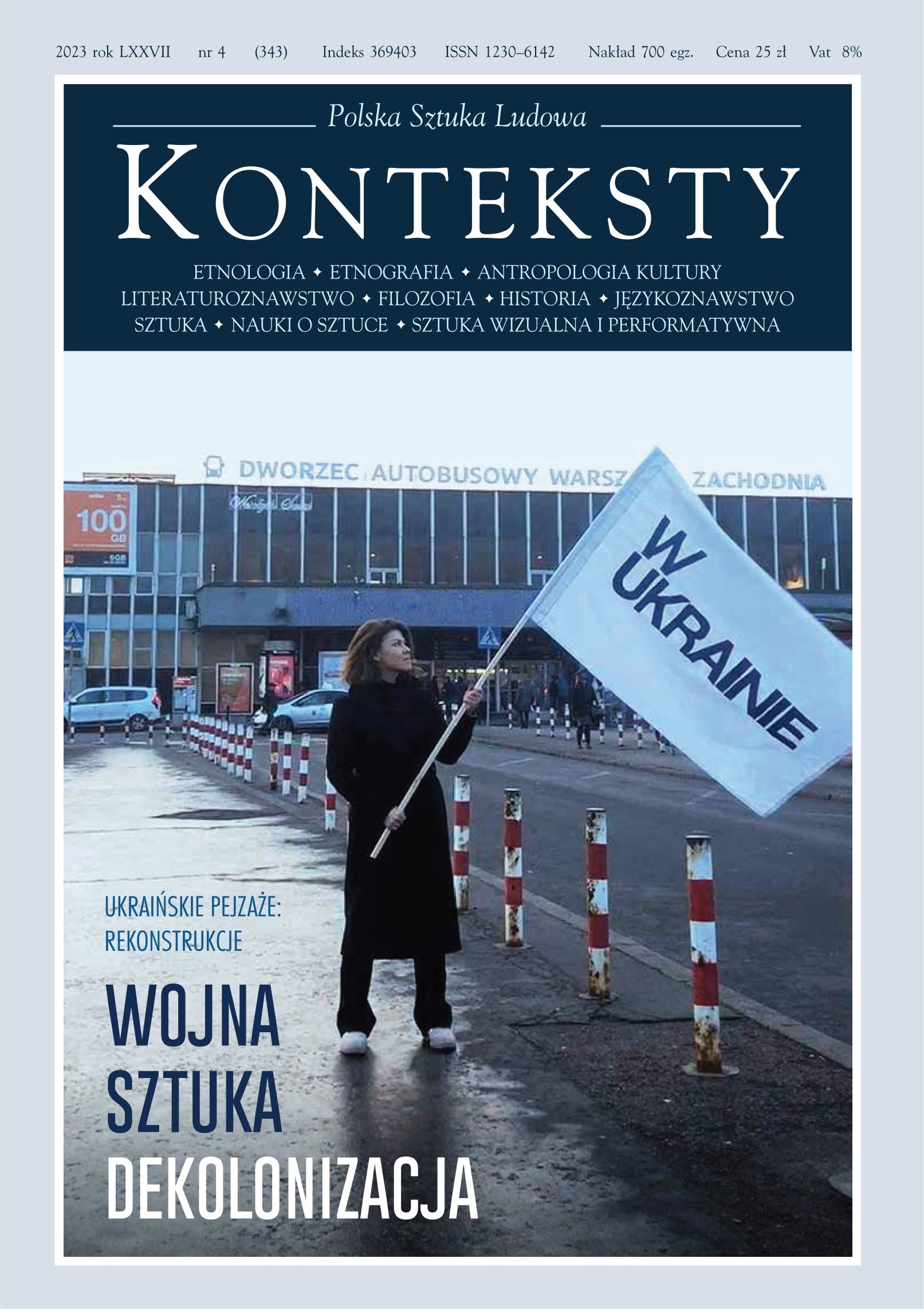“Mise Éire”: Revisions of the Myth of Ireland in Modern Irish Poetry
Maria Fengler
maria.fengler@ug.edu.plUniwersity of Gdańsk (Poland)
https://orcid.org/0000-0001-5009-9705
Abstract
The Celtic myth of the goddess personifying Ireland permeates Irish literature from the earliest legends to the 20th century. The poems from the 1970s and 1980s analysed here, however, point to a rebellion against the myth and the social and political attitudes it projects, defamiliarizing the national narrative through strategies of demythologization, the grotesque and mockery. Seamus Heaney’s poem Bog Queen turns the goddess into a terrifying zombie unleashing ritual violence, while Paul Muldoon’s Aisling – into an anorexic vision leading young men to martyrdom. Eavan Boland demythologizes the figure of Mother Ireland, showing in her stead the historical fate of Irish women: the prostitute and the immigrant mother. In Nuala Ní Dhomhnaill’s mocking portrayal Ireland is Old Gummy Granny, blind and deaf to contemporary reality. The poetic revisions of the myth diagnose the exhaustion of national ideology, indicating the human cost of sacralised violence and the anachronism of the call for blood sacrifice in the modern world.
Keywords:
Mother Ireland, Cathleen Ni Houlihan, aisling, defamiliarization, modern irish poetryReferences
Boland, Eavan. Object Lessons: The Life of the Woman and Poet in Our Time. Manchester: Carcanet Press, 1995.
Google Scholar
Boland, Eavan. The Journey and Other Poems. Dublin: Arlen House, 1987.
Google Scholar
Brewster, Scott. “Abject State: Ritual, Waste and Exile of the Body in Northern Irish Poetry”. In The Body and Desire in Contemporary Irish Poetry, edited by Irene Gilsenan Nordin, 21-39. Dublin: Irish Academic Press, 2006, s. 27-28.
Google Scholar
Brown, Terence. Ireland: A Social and Cultural History 1922-1985. London: Fontana Press, 1985.
Google Scholar
Clark, Rosalind. The Great Queens: Irish Goddesses from the Morrigan to Cathleen Ni Houlihan. Gerrards Cross: Colin Smythe, 1991.
Google Scholar
Clutterbuck, Catriona. “'Mise Eire', Eavan Boland”, Irish University Review, 39, no. 2, (Autumn/Winter 2009): 289-300. https://www.jstor.org/stable/20720408
Google Scholar
Corkery, Daniel. The Hidden Ireland. Dublin: Gill and Macmillan, 1996 (first published 1924).
Google Scholar
Dalton, G. F. “The Tradition of Blood Sacrifice to the Goddess Éire”, Studies: An Irish Quarterly Review, 63, no. 252 (Winter, 1974): 343-354.
Google Scholar
Fulford, Sarah. “Woman and Nation: Readings of Authenticity in Contemporary Irish Poetry”, Studies: An Irish Quarterly Review, 89, No. 354 (Summer, 2000): 130-139. https://www.jstor.org/stable/30095346
Google Scholar
Gender and Sexuality in Modern Ireland, edited by Anthony Bradley and Maryann Gialanella Valiulis. Amherst: University of Massachusetts Press, 1997.
Google Scholar
Glob, P.V., The Bog People, translated by Rupert Bruce-Mitford. Ithaca, New York: Cornell University Press, 1969.
Google Scholar
Green, Miranda. Celtic Goddesses: Warriors, Virgins and Mothers. London: British Museum Press, 1995.
Google Scholar
Gutorow Jacek, „Seamus Heaney: tożsamość i archiwum.” In Poszukiwanie sensów: lekcja z czytania kultury, red. Piotr Kowalski, Zbigniew Libera. Kraków: Wydawnictwo Uniwersytetu Jagiellońskiego, 2006.
Google Scholar
Heaney, Seamus. North. London: Faber, 1992.
Google Scholar
Heaney, Seamus. Zawierzyć poezji, wybór i opracowanie Stanisław Barańczak. Kraków: Wydawnictwo Znak, 1996.
Google Scholar
Jarniewicz, Jerzy. The Bottomless Centre. Łódź: Wydawnictwo Uniwersytetu Łódzkiego, 2002.
Google Scholar
Levine, Joshua, “Europe’s Famed Bog Bodies Are Starting to Reveal Their Secrets”, Smithsonian Magazine, May 2017, https://www.smithsonianmag.com/science-nature/europe-bog-bodies-reveal-secrets-180962770/.
Google Scholar
Longley, Edna. “From Cathleen to Anorexia: The Breakdown of Irelands.” In The Living Stream: Literature and Revisionism in Ireland, 171-195. Newcastle upon Tyne: Bloodaxe Books, 1994.
Google Scholar
Mac Cana, Proinsias, “Aspects of the Theme of King and Goddess in Irish Literature”, Études celtiques, 7, no. 1, 1955: 76-114.
DOI: https://doi.org/10.3406/ecelt.1955.1274
Google Scholar
Muldoon, Paul. Quoof. London: Faber, 1983.
Google Scholar
Ní Dhomhnaill, Nuala. The Astrakhan Cloak, translated by Paul Muldoon. Winston-Salem: Wake Forest University Press, 1998.
Google Scholar
The New Oxford Book of Irish Verse, edited with translations by Thomas Kinsella. Oxford: Oxford University Press, 1989.
Google Scholar
Walter, Katharina. “From Aisling to Chora: Female Allegories of the Nation in Contemporary Irish Women’s Poetry”, Irish Studies Review, 2013: 1-13. http://dx.doi.org/10.1080/09670882.2013.814423
DOI: https://doi.org/10.1080/09670882.2013.814423
Google Scholar
Yeats, William Butler, Yeats’s Poems, edited by Norman A Jeffares. Dublin: Gill and Macmillan 1989.
Google Scholar
Yeats, William Butler. „Cathleen, córka Houlihana”, przeł. Zofia i Lucjan Porębscy. Dramaty irlandzkie, 10-15. Kraków-Warszawa: Instytut Książki, 2011.
Google Scholar
Authors
Maria Fenglermaria.fengler@ug.edu.pl
Uniwersity of Gdańsk Poland
https://orcid.org/0000-0001-5009-9705
Maria Fengler – anglistka, tłumaczka, adiunktka w Instytucie Anglistyki i Amerykanistyki Uniwersytetu Gdańskiego. Autorka nagrodzonej przez „Literaturę na Świecie” monografii irlandzkiego poety Michaela Longleya Między Itaką a Belfastem (2010) oraz artykułów na temat współczesnej poezji i prozy irlandzkiej; współredaktorka monografii wieloautorskich Między słowem a rzeczywistością. Poezja Eliota wobec cielesności i Wcielenia (2015) i Striking the Chords of Spirit and Flesh in Polish Poetry (2016); współredaktorka polskiego przekładu Towards a Christian Poetics M. Edwardsa (Ku poetyce chrześcijańskiej, 2017).
Statistics
Abstract views: 318PDF downloads: 120
License
Copyright (c) 2025 Maria Fengler

This work is licensed under a Creative Commons Attribution 4.0 International License.







